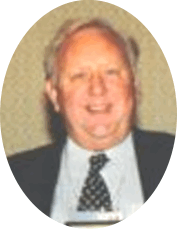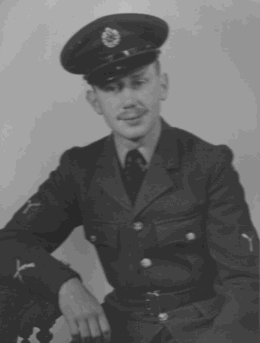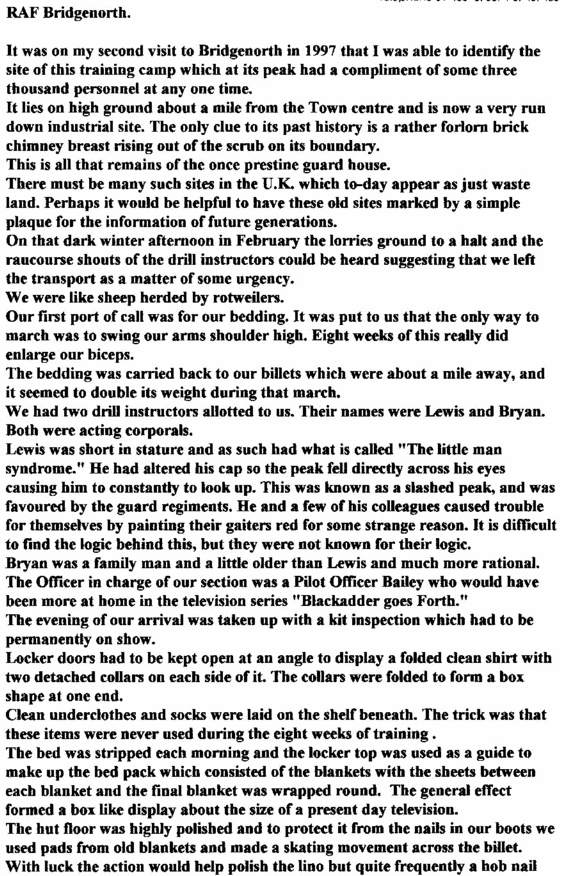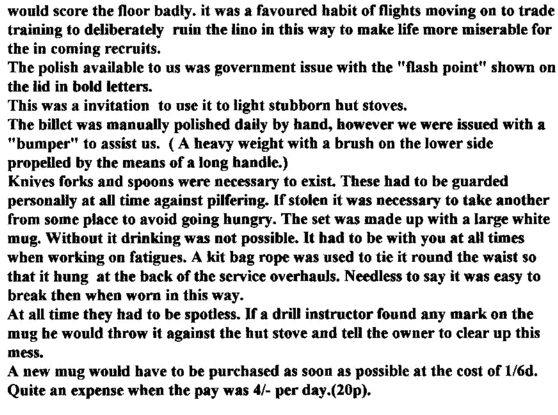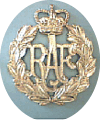Foreword from Webmaster
Bernard Parke left the RAF in 1958 shortly after his National
Service finished and having to compete with new school leavers found
it difficult to find a job. He fiinally joined Lloyds Bank Ltd., and
after hours of evening work after a long day he became a qualified banker
and taught banking part time for nine years.
He left Lloyds and joined Barclaycard retiring at the
age of sixty as New Business Manager Large corporate Business, then
became a Borough Councillor serving as Mayor of Guildford in 1989-90
and then deputy Mayor for a further year after which he was defeated
in the polls.
His hobbies are full-bore target rifle shooting and he
served as Captain of Barclays Bank rifle club before it was dsbanded.
Bernard married in 1969 and I has two children and two grand children.
Hampden Park - RAF Beachy Head
I wonder how many people living in the quiet cul-de-sac
in Hampden Park known as Kings Drive realise the part that their houses
played at the height of the cold war.
To many National Service Men in the fifties it was home
from home, a far cry from the cold wooden barrack huts of Bridgenorth
and Compton Bassett. Such structures would not have been welcomed by
the Eastbourne City Fathers of those days and so we enjoyed the luxury
of the houses which still remain almost as they were then.
Almost the same, for then there were large heating ducts
running at the rear which carried a central heater system from a remote
solid fired boiler house. North Sea Gas would not be discovered and
in use for at least three more decades.
The only remaining ancillary building now is the old Officers mess now
used by the A.T.C.
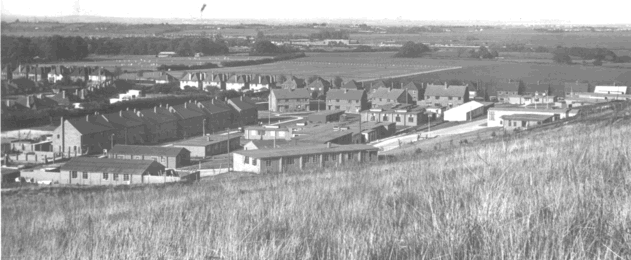
Immediately opposite stood the Guard room with its adjacent
E.T. which was not used for phoning home. There were houses on the right
side of the approach road to The Guard Room which were the homes of
the married N.C.O., whilst the Married Commissioned Officers were housed
in the houses adjoining the main Road way. The C.O.,a Squadron Leader‘s
house was the first.
On leaving the Guard room the ground falls away, to the
right of which was situated the Sick Quarters. The M.O. was a local
civilian doctor who held a surgery at frequent intervals. The library,
cook house and NAAFI were based in the central buildings, and the administration
office was just below them. Our Transport, or M.T. Depot , was to be
found in the area to the left of the picture from which just can be
seen a fuel pump the low roofed building in front of the row of houses
was the home of the NAAFI girls.
A place familiar to me for on one wet winter night I decided
not to go into the Town and drink with the others. I did not like wasting
money in that way as it was in short supply. I went to bed with the
book “To catch a Thief “and a tin of grapefruit juice (Fruit
juice was both expensive and rare in those days.) I forgot to lock my
door and to my horror it burst open and the revellers entered and managed
to remove my regulation pyjamas and carried me naked to the Girls quarters
not forgetting to ring their door bell.
I have never run back to the billet so fast in my life .Fortunately
they did not come to their door.
Beyond the picture shown as an open space, is now the
site of the new hospital, but we used it as a foot ball and games area.
Sport was a main pursuit during the summer months when we were not occupied
in our Beachy Head Nuclear proofed centre watching The type 80 strobe
relentlessly sweeping the night sky , from The Thames Estuary to lands
end. The night shifts were solitary occasions with just one Console
operator and the endless singing of Old Blue Eyes or Tab Hunter , played
on a Dansette record player with the then new L.P. Records which had
just replaced the old E.P. Records.
The rest of the watch would await their turn in the rest
room or be ready to fully man the station immediately should the Ruskies
decide to pay us a visit. Some tried to sleep in the most curious places.
Looking back I wonder how safe they were from radiation as little was
known of it them. We heard tales of Americans dying from exposure to
the radar signals, in fact one officer would not go near the Type 80
in case it made him infertile.
In our ignorance we thought this very amusing. We were still testing
H Bombs at Woomera and the Christmas Islands, it was not until the late
fifties that there was talk of the dreaded strontium ninety. I wonder
how many of our colleagues that were on station during those tests are
still in good health to-day.
There was one old black and white T.V. in the library
area which held little attraction for us. Many of the houses had cable
type radios which gave a very poor reception and were only used to listen
to Radio Luxemburg. Transistor radios were still in the development
stage, but there were portable sets which had valves and were very fragile.
They were powered by two batteries which made them costly to use.
We preferred to go into the Town to see the brilliant
new Hollywood films such as the King and I. Frothy Coffee was all the
range at nine old pence a cup. There was a favourite haunt in Terminus
Road called Bird Land. The back of the bar was the home of a collection
of budgerigars which I am sure would not be allowed by to-day’s
health inspectors. Saturday nights would probably find us in the dance
hall on the pier. This was the time of skiifle groups and the local
would be pop stars who made double bases out of the old type tea chests
and used the old style wash boards in imitation of the favourite stars.
This is a time before the Beatles even appeared at the Cavern.
There were six ladies colleges in Eastbourne in those
days which made life interesting. Eastbourne was very much a major holiday
resort and some of the boys used to boast that they would see off one
set of female holiday makers and stay at the station to pick up a fresh
selection who were just arriving for a week or two in The Sun Trap of
the South. The Station rather resembled something like Waterloo as service
personal were returning from weekend leave would try and rush the poor
man on the ticket barrier as many did not have the proper fare
During the summer months day trips to France were offered
for something like 12/6d. Well above our spending capacity.
Life on the site was never too dull. We worked out many schemes that
the pedestrian type regular N.C.O’s never worked out. One ruse
was to always carry a piece of paper when walking around the camp. The
Officers and NCO’s would assume that the person carrying the paper
was allocated to a task and not ask were they were going.
The clerk making out the parade states was a very popular
person. For although this was a small encampment, if the person’s
name did not appear on the parade state he could stay in bed. The Sergeant
would never think of walking to the house a few feet away to see why
some airmen never went on parade.
One particular Flight Sergeant would always boast that he had a birth
certificate which seemed strange to us for we would never bring such
a thing up in conversation with one another!
Hunting for Badgers and Bears in Sussex on Twenty Two and a Half Pence
a day all found.
Beachy Head now as it was in the fifties was noted for people taking
their own lives, but up until the early nineteen sixties it was very
much dedicated to saving our countrymen’s lives against an assault
from the evil empire as the communist world was known at that time.
It was the home of R.A.F. 880 signal unit Fighter Command Eleven Group.
It housed the latest in Radar Technology, a huge Radar
antennae known as a type 80. It spanned at least thirty feet and rose
to a height of some twenty five feet. It was powered by two fifty horse
power electric motors which were able to rotate the aerial at a constant
four revolutions a minute even in the strongest winter gale.
It scanned the cold war skies to a height of seventy five
thousand feet and stretched its invisible fingers some three hundred
and sixty miles. The longest possible in those days, for radar waves
are not bounced back to earth but leave at a tangent into unknown space
with its point three degree pulse. The type eighty was at the cutting
edge of technology. It had replaced the inferior American gear known
as F. P.S 3 whose signal tended to create lobes at its extremity . Aircraft
plots would suddenly disappear and reappear without warning making tracking
very difficult. The height finding gear known ( A type fourteen) as
nodding horrors as they constantly measured the height of plot above
ground level to their actual elevation.
The type fourteen was an adapted plotting aerial known as a type seven.
The display was shown in two forms. In console form and in a P.D.U.
form resembling the fighter plotting tables shown in films, with this
difference.
Beneath the P.D.U. was a projector. The film was developed
in fifteen seconds and projected up on the under side of the unit. There
was a four minute warning of attack in the fifties, which did not leave
us much time to scramble our Hawker Hunters from Tangmere.. A controller
and various plotters would gather around in some sort of pecking order.
The most important and cherished position was known as Beachy Head long
range south which stretched into the heart of France.
We would often intercept French Military aircraft flying over France
which was not appreciated by our French counterparts.
Our main purpose was to give warning of a possible Russian attack of
Bombers which bore the NATO code names of Badgers and Bears. The more
elite were given Ground Control interception roles.
They were a small team consisting of a controller who would guide a
fighter on to its Quarry. The Fighter pilot would call out “Tally-ho”
when he had made contact and “Murder-Murder” when the plane
had been disposed of.
The most important man apart from the controller was the Dead Reckoning
man. He would physically plot the aircraft on a free standing map and
at any time be expected to give an immediate course and direction to
our fighter so that it might return to base quickly and safely. The
lowest man in the team was the R.T. Man. Again he would write down a
record of the whole happenings. There were no tape recordings available
to us then. We controlled all weather fighters at night. These were
ageing meteors Known as N.F.14 .( Meat Boxes) They had a long protruding
noise in which a primitive radar gear was stored. In the later months
the Javelin was to replaced these fighters, they were two seater delta
all weather fighters.
We were asked to join these crews as air borne radar operators. We were
to receive the rank of sergeant with a princely twelve pounds a week.
I am told most of these recruits spent most of their time being air
sick.
The fighter was not a great success despite its design and almost melodious
sounding jets engines. These aircraft were based at Odiham
We also controlled Americans who were then based at Manston. They flew
F86 D’s . We could never understand their R.T. procedure and names
would be called and they would tend to go back to their bases in a state
of high dudgen right across the civilian air lanes without clearance.
For amber one and amber two were in this area. We had little time for
our American cousins as we saw rather as competitors rather than allies.
They used to be fair weather flyers, for in good weather they would
swarm like bees into the skies.
On such a morning I was on Movement liaison taking down aircraft movement
on an A4 map covered in cellophane from Stanmore. We had to use china
graph pencils which were not ideal, I was so busy that I plotted a Delta
Golf as a Delta Charlie. One position is over Holland and the other
over central France, the air lanes, Amber one and amber two were fixed
then at only three to nine thousand feet.
B.E.A . had then just received the new Vickers Viscount which flew way
above amber one and amber two at twenty two thousand feet.
The Type 80 picked up the plot and it was quickly Xrayed as a possible
incoming attack as my plot was some hundred or so miles out.
These privileged passengers were returning from a leisurely trip to
Paris when they were intercepted by two RAF Hunters. It must have been
quite an experience for then , as for me I was fortunate in talking
my way out of a court marshal. A plea of insanity did come to mind at
the time.
It was at that time we were a world power, just before the water-shed
of Suez, but that is another story
Bernard Parke
Ex Sac “ Whoofer “ 2786275
E mail to Webmaster
Back to: Service
Stories
Back to: Home Page
|
